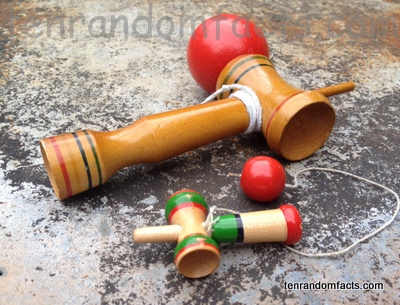Flick up the kendama ball and catch it on the stick.
- A kendama is a traditional Japanese toy, typically made of wood.
- Kendama are historically hammer-shaped with a spike, and have a ball attached with string.
- Kendama have four main parts: ‘ken’ (stick or handle), ‘crosspiece’ (cup body), ‘string’, and ‘ball’ , and the toy usually has three different cup sizes to balance the ball on.
- The aim of a kendama is to get the ball onto the spike or catch it on one of the sides of the hammer.
- A ‘kendama’ is also known as ‘ring and pin’, and it is similar to the European cup-and-ball toy.
- Kendama are particularly common in Japan, where trick competitions are held.
- While some people think that the kendama toy originated in Japan, it possibly came to the country by trade in the 1770s from the French, who had a similar toy named a ‘bilboquet’, to which the Japanese made some modifications.
- The modern kendama was patented by Japanese Hamaji Egusa in 1920 and the official competition design came from the 1970s.
- The string on a kendama is typically between 35 to 45 centimetres (1.1 to 1.5 feet) in length; a longer string makes it harder to complete the aim.
- The grip and stance of kendama change the performance, with specific recognised standards of each.
Bibliography:
Kendama, 2013, Wikipedia, http://en.wikipedia.org/wiki/Kendama
Kendama, n.d, Kids Web Japan, http://web-japan.org/kidsweb/virtual/kendama/kendama01.html






